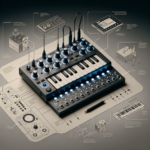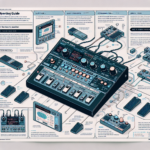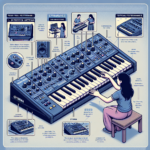Keith McMillen SoftStep: Comprehensive Guide to Features, Setup, and Performance

Introduction
The Keith McMillen SoftStep is a versatile and innovative MIDI foot controller designed to offer musicians and producers a high degree of control over their digital audio workstations (DAWs) and other MIDI-enabled devices. Targeted at both live performers and studio musicians, the SoftStep aims to provide a flexible and intuitive interface for controlling various aspects of music production and performance.
Keith McMillen Instruments (KMI) is a well-respected brand in the music technology industry, known for its innovative and high-quality MIDI controllers. The company has a reputation for pushing the boundaries of what MIDI controllers can do, and the SoftStep is no exception.
Key Features Overview:
- 10 pressure-sensitive foot pads
- LED backlighting for visual feedback
- Customizable MIDI mapping
- Lightweight and portable design
- Advanced features like aftertouch and X-Y control
Design and Build Quality
Physical Design
The SoftStep features a sleek and compact design, measuring approximately 17.5 inches in length and 4.5 inches in width. It weighs just under 1.3 pounds, making it one of the lightest foot controllers on the market. The unit is constructed from durable materials, including a robust rubberized surface that provides excellent grip and tactile feedback.
Portability
Given its lightweight and compact design, the SoftStep is highly portable. It can easily fit into a backpack or gig bag, making it an ideal choice for musicians who need a reliable controller on the go. The unit also comes with a custom carrying case for added convenience.
Durability
The build quality of the SoftStep is impressive. The rubberized surface and sturdy construction ensure that it can withstand the rigors of regular use, whether in the studio or on stage. The foot pads are designed to be both responsive and durable, providing consistent performance over time.
Setup and Configuration
Initial Setup
Setting up the SoftStep is straightforward. Follow these steps to get started:
- Connect the SoftStep to your computer using the included USB cable.
- Power on the device by pressing the power button.
- Launch the SoftStep Editor software on your computer.
- Follow the on-screen instructions to configure the device settings.
Software Installation
The SoftStep requires the installation of the SoftStep Editor software, which is available for download from the Keith McMillen website. The software is compatible with both Windows and macOS operating systems. Once downloaded, follow the installation prompts to complete the setup.
Compatibility
The SoftStep is compatible with a wide range of operating systems and DAWs, including:
- Windows 7 and later
- macOS 10.10 and later
- Ableton Live
- FL Studio
- Logic Pro
- Pro Tools
- Reason
Features and Functionality
Key Features
The SoftStep boasts a range of features designed to enhance your music production and performance experience:
- 10 Pressure-Sensitive Foot Pads: Each pad is capable of detecting varying levels of pressure, allowing for expressive control.
- LED Backlighting: The pads are backlit with LEDs, providing visual feedback and making it easy to see in low-light conditions.
- X-Y Control: The foot pads can detect movement in both the X and Y axes, enabling advanced control options.
- Aftertouch: The SoftStep supports aftertouch, allowing for additional expression in your performances.
Customizability
One of the standout features of the SoftStep is its high degree of customizability. Users can easily map the foot pads to various MIDI functions using the SoftStep Editor software. This allows for a tailored experience that can be adapted to suit individual needs and preferences.
Unique Functions
The SoftStep offers several unique functions that set it apart from other MIDI controllers:
- Nav Pad: A dedicated navigation pad allows for easy menu navigation and parameter adjustments.
- Toggle Mode: This mode allows users to switch between different control presets on the fly.
- Step Sequencer: The SoftStep can function as a step sequencer, enabling complex rhythmic patterns and sequences.
Integration with DAWs
The SoftStep integrates seamlessly with popular DAWs, offering pre-configured templates for software like Ableton Live, FL Studio, and Logic Pro. This makes it easy to get started and ensures a smooth workflow.
Advanced Features
In addition to its core features, the SoftStep offers several advanced functionalities:
- Aftertouch: Provides additional expressive control by responding to pressure applied after the initial touch.
- Arpeggiator: Built-in arpeggiator for creating complex rhythmic patterns.
- Chord Mode: Allows users to trigger chords with a single foot pad press.
Performance
Latency and Responsiveness
The SoftStep excels in terms of latency and responsiveness. The pressure-sensitive foot pads provide immediate feedback, ensuring that your inputs are registered accurately and without delay. This makes it an excellent choice for both live performances and studio sessions.
Real-World Usage
In practical scenarios, the SoftStep performs admirably. Whether you’re using it to control effects in a live setting or to trigger samples in the studio, the device offers reliable and consistent performance. The LED backlighting is particularly useful in low-light environments, such as on stage.
User Experience
User feedback for the SoftStep has been overwhelmingly positive. Many users praise its versatility, ease of use, and robust build quality. The high degree of customizability is also frequently mentioned as a standout feature.
Applications and Use Cases
Beginner vs. Professional Use
The SoftStep is suitable for both beginners and professionals. Its intuitive interface and pre-configured templates make it accessible for newcomers, while its advanced features and customizability offer plenty of options for seasoned musicians and producers.
Studio Use
In a studio environment, the SoftStep can be used for a variety of tasks, including controlling DAWs, triggering samples, and manipulating effects. Its compact size makes it a great addition to any studio setup.
Live Performance
The SoftStep shines in live performance settings. Its durable build and responsive foot pads make it an excellent choice for controlling effects, looping, and other live performance tasks. The LED backlighting ensures that you can see the controls clearly, even in dimly lit venues.
Specific Genres
The SoftStep is versatile enough to be used across a wide range of musical genres. However, it particularly excels in genres that require a high degree of control and expressiveness, such as EDM, hip-hop, and experimental music.
Pros and Cons
Pros:
- Highly customizable
- Lightweight and portable
- Durable build quality
- Responsive foot pads
- Seamless DAW integration
Cons:
- Steep learning curve for beginners
- Requires software installation
- Limited standalone functionality
Common Issues and Troubleshooting
Known Issues
Some users have reported issues with the initial setup process, particularly with driver installation on certain operating systems. Others have mentioned occasional connectivity issues when using the device with older computers.
Troubleshooting Tips
- Ensure that you have the latest version of the SoftStep Editor software installed.
- Check for firmware updates on the Keith McMillen website.
- Try using a different USB port or cable if you experience connectivity issues.
Customer Support
Keith McMillen Instruments offers robust customer support for the SoftStep. Users can access a comprehensive knowledge base on the company’s website, as well as contact customer support via email or phone for additional assistance.
Comparisons with Similar Controllers
Competitor Comparison
When compared to similar MIDI foot controllers, such as the Behringer FCB1010 and the Roland FC-300, the SoftStep stands out for its lightweight design and advanced features. While the FCB1010 offers more foot switches, it lacks the pressure sensitivity and customizability of the SoftStep. The FC-300, on the other hand, is bulkier and less portable.
Feature Comparison
The SoftStep excels in areas such as customizability, portability, and advanced features like aftertouch and X-Y control. However, it may fall short for users who require a larger number of foot switches or more robust standalone functionality.
Conclusion
Summary
The Keith McMillen SoftStep is a highly versatile and innovative MIDI foot controller that offers a range of features designed to enhance both live performances and studio sessions. Its lightweight design, advanced features, and high degree of customizability make it a standout choice in its category.
Who Should Buy This?
The SoftStep is ideal for musicians and producers who require a flexible and portable MIDI foot controller. It is suitable for both beginners and professionals, offering an intuitive interface and advanced features to meet a wide range of needs.
Final Thoughts
Overall, the Keith McMillen SoftStep is a well-designed and highly functional MIDI foot controller that offers excellent value for money. Its combination of portability, customizability, and advanced features make it a top choice for musicians and producers looking to enhance their setup.
FAQ
Is the SoftStep compatible with my DAW?
The SoftStep is compatible with a wide range of DAWs, including Ableton Live, FL Studio, Logic Pro, Pro Tools, and Reason.
Do I need to install any software to use the SoftStep?
Yes, you will need to install the SoftStep Editor software, which is available for download from the Keith McMillen website.
Can I use the SoftStep without a computer?
While the SoftStep is primarily designed to be used with a computer, it can also be used with other MIDI-enabled devices via a MIDI expander.
How do I update the firmware on my SoftStep?
You can update the firmware using the SoftStep Editor software. Check the Keith McMillen website for the latest firmware updates and follow the instructions provided.
Where to Buy
The Keith McMillen SoftStep can be purchased from a variety of retailers, including major music equipment stores like Guitar Center, Sweetwater, and Sam Ash. It is also available directly from the Keith McMillen Instruments website.




